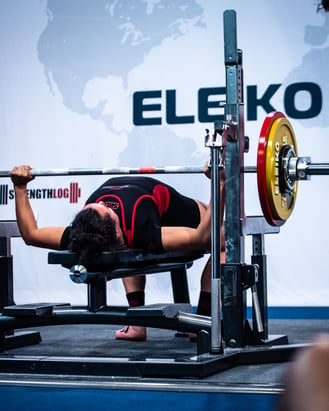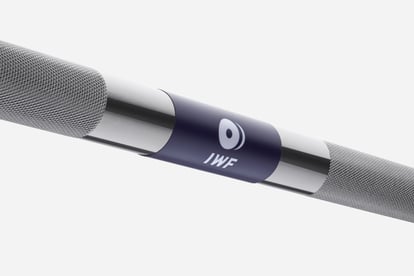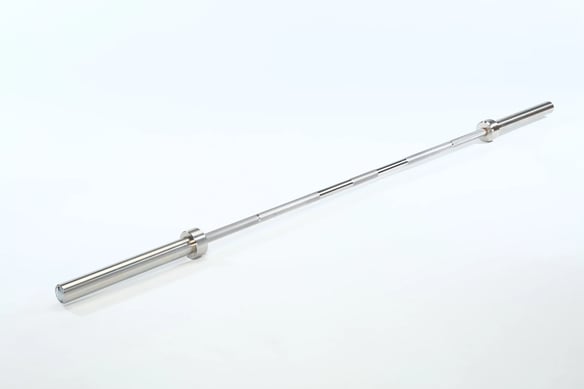I've been working with Olympic bars and Olympic lifting for decades. And I will definitely say that understanding the difference between even normal 7-foot Olympic bars is confusing to a lot of people. Heck, I had to brush up before writing this!
We sell Olympic bars here at ConnectFit anywhere from $150 up to $1,300. That's a good amount of price range! So what makes a better bar?
We sell Olympic bars here at ConnectFit anywhere from $150 up to $1,300. That's a good amount of price range! So what makes a better bar?
Your normal Olympic Bar is a 20 KG Bar, which is about 44 lb. It's supposed to be 2.2 meters, which is 7.2 ft. There are different types of training bars and specific bars that can weigh less or can be a little shorter or even a little longer, but that is the basic size. I had a bar made for an old company that was longer in the shaft to fit in a specific application.
The first difference will come off the shaft diameter and in the knurling. Your normal diameter is 28 to 29 mm, but for some specific training bars and youth bars you're going to find 25 mm diameters. There are also beefy bars with slightly wider shafts, 30-32mm, which are sometimes preferable for pressing or squatting, since you are pushing without rotation.
The plate horn, or sleeve of the bar should be 49.8mm-50mm, and this is one of those places that cheap bars show up, since better olympic plates are toleranced to be tight to this size. I've certainly had clients with cheap plates or cheap bars (or both!) have issues with too tight or too loose bars and plates.
The plate horn, or sleeve of the bar should be 49.8mm-50mm, and this is one of those places that cheap bars show up, since better olympic plates are toleranced to be tight to this size. I've certainly had clients with cheap plates or cheap bars (or both!) have issues with too tight or too loose bars and plates.
Generally, there are two major types of normal 7-ft bars. These are Olympic versus Power bars. Though there are some hybrid bars in between them, which we'll also talk about.
Power bars are much more rigid and stiff. They don't have any elastic bounce, because they're made for heavy deadlifts heavy squats and heavy bench presses. Not compound lifts.

On the other hand, Olympic barbells are designed around the snatch, and the clean and shark. In other words, they are built for those explosive, compound lifts that depend a little bit on the elasticity of the bar. That elasticity is also called the whip of the bar.
An easy way to tell the difference if you don't know anything else is that the lifting marks on the knurling are normally a little bit further out than the power bar. And that's normally how you can tell the newer hybrid bars, they will have both types of hash marks. For 90% of the users and uses, the hybrid bars are actually a very good choice.
Also, most powerlifting bars like to have some knurling in the center, call the center knurl. On a really good bar, the center knurling is softer than the rest of the knurling. But this is pretty exclusive. Also, most of the hybrid bars do not have a center knurl.

We often are given the tensile strength of a bar and are supposed to infer the quality level of the bar with it. The reason this is inferred is because the tensile strength of a bar is how much pounds per square inch stress it can take being pulled apart. We don't pull apart the bars ever. But we'd really like to know is the deforming or breakage point of a bar, and few manufacturers give us that.
There's also the assembly and quality of sleeve. The sleeve is the rotating horn at the end of the bar. We often look at bushings versus bearings here. Bearings, and especially needle bearings are superior in most cases to bushings, but bearings add a lot to the production price of the bar.
You can get away with good bronze bushings. But when you see brass or Steel bushings, that's normally a much cheaper type of bar.
Needle bearings are normally what you find on your top quality Olympic weightlifting bars. But again, most of us will appreciate or need the difference.
We will go into the protective coatings in the type of those later on. Just understand that most of these bars are going to be Chrome or zinc, and some are cerakote. I like black oxide and black zink bars because of the feel. Black oxide is not super durable but black zink is good. Your hard Chrome is normally the best. But a lot of cheap bars are decorative Chrome that chips off. This is normally what you're looking at when you go below $150 in a bar.
We carry Olympic bars from Hudson Steel, TKO, Hampton, Legend, Ivanko, and Eleiko. And as I said, these will go from $150 up to $1,300. Let us know if you'd like to order a bar, or if you'd like some more information.





COMMENTS